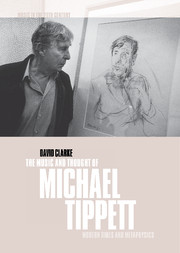Book contents
- Frontmatter
- Contents
- Acknowledgements
- References to Tippett's scores and essays
- 1 Tippett and the ‘world vision’ of modernity
- 2 The significance of the concept ‘image’ in Tippett's musical thought: a perspective from Jung
- 3 Back to Nietzsche? Transformations of the Dionysiac in The Midsummer Marriage and King Priam
- 4 Metaphysics in a cold climate: The Vision of Saint Augustine
- 5 ‘Shall we …? Affirm!’ The ironic and the sublime in The Mask of Time
- 6 The meaning of ‘lateness’: mediations of work, self and society in Tippett's Triple Concerto
- 7 The golden bird and the porcelain bowl: Byzantium and the politics of artefacts
- Notes
- Bibliography
- Index
4 - Metaphysics in a cold climate: The Vision of Saint Augustine
Published online by Cambridge University Press: 13 October 2009
- Frontmatter
- Contents
- Acknowledgements
- References to Tippett's scores and essays
- 1 Tippett and the ‘world vision’ of modernity
- 2 The significance of the concept ‘image’ in Tippett's musical thought: a perspective from Jung
- 3 Back to Nietzsche? Transformations of the Dionysiac in The Midsummer Marriage and King Priam
- 4 Metaphysics in a cold climate: The Vision of Saint Augustine
- 5 ‘Shall we …? Affirm!’ The ironic and the sublime in The Mask of Time
- 6 The meaning of ‘lateness’: mediations of work, self and society in Tippett's Triple Concerto
- 7 The golden bird and the porcelain bowl: Byzantium and the politics of artefacts
- Notes
- Bibliography
- Index
Summary
Reframing the critical debate
The Vision of Saint Augustine (1963–5) is a remarkable work: Tippett's most sustained attempt to convey a human being's experience of what allegedly lies beyond human being. On the face of it, the piece and its attempted subject matter, Augustine's vision of eternity, threaten to set the commentator an equally sublime task: to show how music, the epitome of temporal artforms, reveals through its own essence the essence of time and what lies beyond it. Fortunately, though, the work is not about time in such a pure sense. Its preoccupation with temporality is, I will argue, infused by the temporal concerns of this (material) world, and while exploring those mediations will be tricky enough, this is at least a less terrifying prospect than what might have been had Tippett indeed succeeded in musically mapping time and eternity as absolutes.
There are other ways too in which our investigative business is not quite what it first appears to be. Tippett's own commentary on the work, especially his essay ‘Music of the angels’, is as significant for what it neglects to discuss as for what it actually says. This is not to suggest deliberate dissimulation; we can certainly detect where the poetic metaphors of the angelic choir have made their mark on the piece. But it is questionable whether these alone point to what the work is ‘about’, any more than Tippett's references to, say, the vocal device of glossolalia are keys to its musical structure.
- Type
- Chapter
- Information
- The Music and Thought of Michael TippettModern Times and Metaphysics, pp. 96 - 146Publisher: Cambridge University PressPrint publication year: 2001

